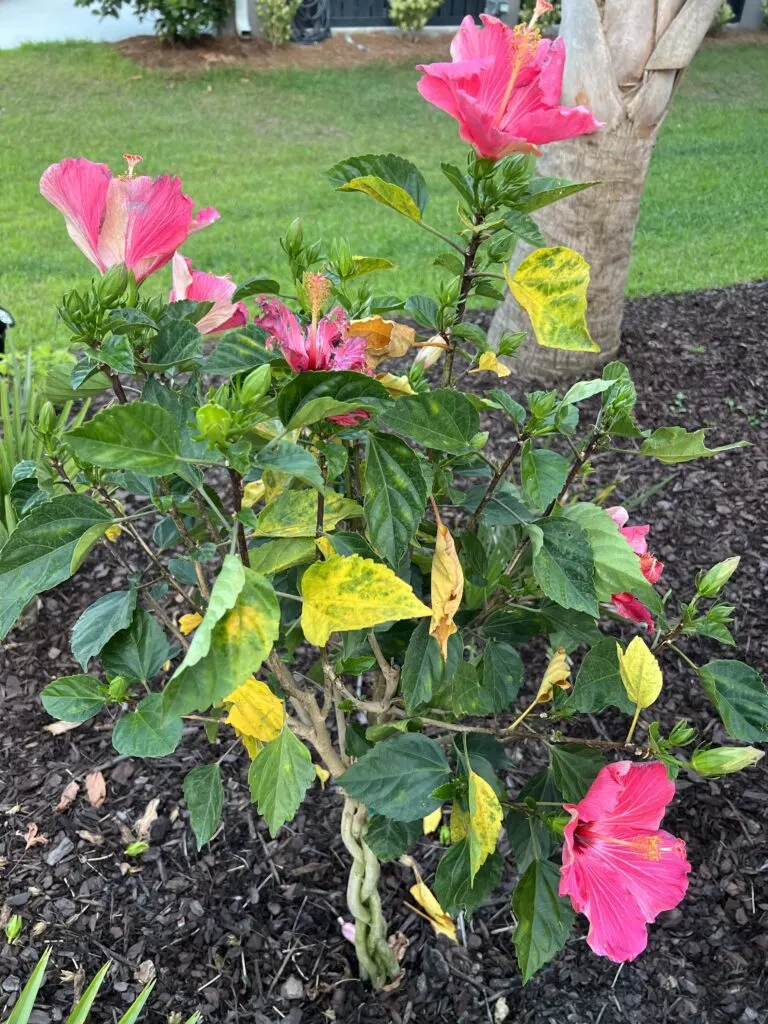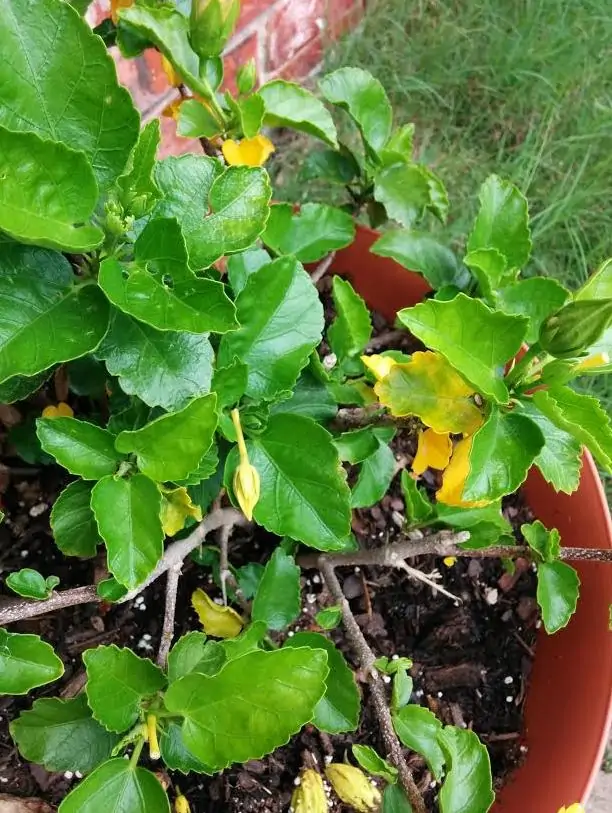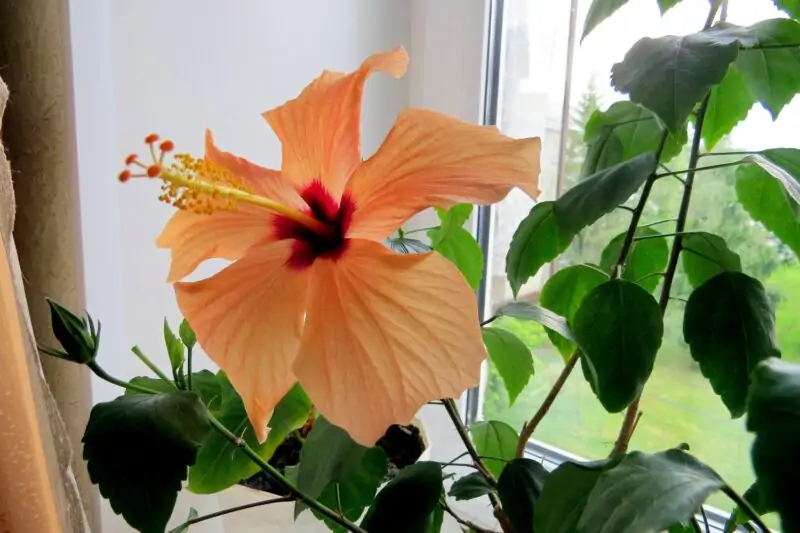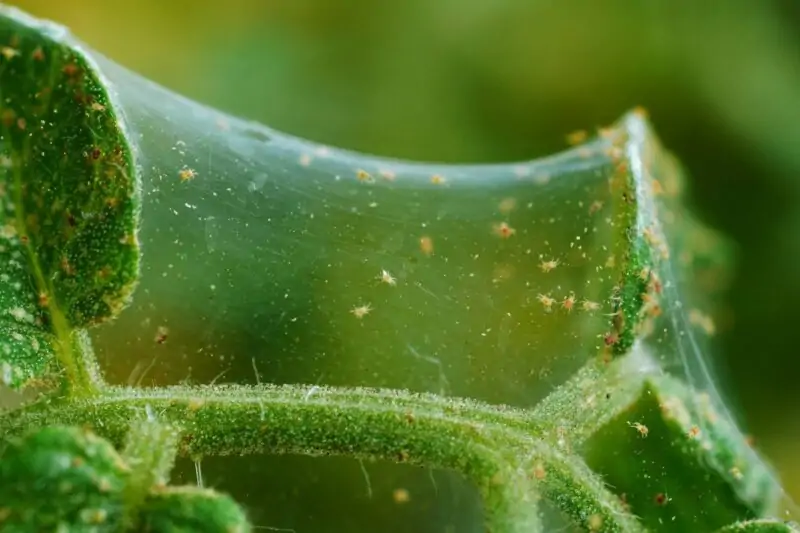7 Reasons Why Your Hibiscus Leaves Are Turning Yellow

Warning: Undefined property: stdClass::$error in /sites/makeoveridea.com/wp-content/themes/theissue/inc/misc.php on line 71
Are your hibiscus leaves turning yellow? Don’t panic! Yellow leaves on hibiscus are a common problem that can be solved with the right care.
Hibiscus plants are popular for their vibrant flowers, but when their leaves are yellowing, it’s a sign that something isn’t quite right. Factors that cause the leaves to turn yellow can range from drought stress to overwatering to nutrient deficiencies, among others.
In this article, we’ll cover everything you need to know about the reasons why your leaves will turn yellow on your hibiscus plant and how to revitalize your plant so that it returns to health.
Reasons for Hibiscus Leaf Yellowing
Yellow hibiscus leaves indicate that there is something wrong with your plant. Several reasons could cause this issue, including:
Drought Stress Yellows Hibiscus Leaves
Drought stress occurs when there is not enough water available for root uptake, leading them unable to function properly.
Causes of Drought Stress
- Underwatering: The most frequent reason for drought-stressed plants. While you may often hear advice not to give your plant too much water, underwatering is another extreme you should avoid. Both too much or too little water is bad for your plant. Check the soil regularly to find out whether it is too dry. A spell of hot dry weather can also lead to heat stress and water quickly evaporating from the soil.
- Excess Wind: This can lead to root systems and, consequently, the entire plant drying out quickly, making it hard for the photosynthesis process.
- Fast-draining soils: Soil lacking organic matter does not retain moisture well, causing it to dry up quickly, even if you pour a lot of water into the pot.
- Insufficient watering frequency or amount: Not providing adequate quantities or frequency leads to soil content being less humid than required, even if irrigation is applied regularly at timed intervals: you don’t keep the soil moist enough.
- Dormancy: If it is too cold outside, your hibiscus can also decide to go into hibernation. Keep your plant indoors during the winter.
- Excessive foliage: In some cases, there are too many leaves on your plant so it cannot feed them all equally well, especially if your plant is getting not enough nutrients. Pruning older leaves might be an answer.
Rejuvenating Drought-Stressed Hibiscus
If you notice signs like leaf wilting and/or curling at the edges, it’s important to take immediate steps as a delay means that your hibiscus may die of dehydration. This involves rejuvenating measures, including:
- Soak Your Plant Well:
Soaking allows water to reach deep into the root system while moistening the surrounding soil and giving your hibiscus exactly what it needs. It helps prevent future instances of drought stress. - Protect From Winds:
Wind dries out both foliage and ground soil around your hibiscus tree quickly. Make sure to protect your plant from drying winds. - Mulch the Soil:
Mulching retains soil moisture and creates a barrier over it, preventing evaporation of water content in the ground, thereby preserving humidity levels around roots. - Water As Needed:
Provide adequate amounts of water at regular intervals. - Spritz The Leaves:
Spraying mist on foliage helps increase local humidity levels, also helping keep them hydrated along with their surrounding region.

Overwatering Causes Yellow and Drooping Hibiscus Leaves
Overwatering is another common problem that can also cause hibiscus leaves to turn yellow. This occurs due to heightened moisture content, causing root rot or suffocation, leading to the leaves of the plant to yellow and fall. If this problem is not properly addressed, your hibiscus may wilt, droop, or collapse.
Causes Of Overwatering
- Slow-draining soils: Soil lacking proper drainage means excess water retention within the potting container leads to saturation, resulting in slow absorption by roots.
- Excessive watering frequency/intensity: Frequent watering without allowing time for the soil to completely dry out between each irrigation session will lead to an accumulation of surplus fluid quantity in the substrate. This can create anaerobic conditions, making it harder for oxygen and nutrient uptake by plant parts.
Solutions For Over-watered Issues
- Improve Soil Drainage:
Use containers with drainage holes at the bottom surface and use a medium containing perlite or coarse sand. This ensures better permeability, thus ensuring better drainage and lessening the chances of a saturated or anaerobic environment. - Adjust Water Practices:
Cut back on watering your tropical hibiscus plant.
Potted Hibiscus Leaves Yellowing

Growing hibiscuses in pots is very popular because these plants because they add beauty indoors, but even if the plant never leaves your room, hibiscus leaves can turn yellow and fall too. This could be caused by several reasons, such as:
- Lack Of Space in the Pot
If there’s not enough space in the planter container where they grow, then root systems might get congested, creating difficulty while absorbing water and nutrients required for growth, leading to yellowing. Keep your hibiscus in a pot that is large enough for it and replant when necessary. - Depleted Soil Nutrients
A plant can only thrive if the soil it’s planted in has all the necessary nutrients available. Being potted, hibiscus plants grow in limited containers, meaning that their nutrient supply quickly diminishes: the plant will react with yellow leaves if fertilizing is not frequent enough to keep the soil fertile. - Lack Of Light
Hibiscus plants require a lot of direct sunlight to maintain healthy green foliage. Without your plant getting enough light exposure, leaves might start turning yellow. Cool and dark partial shade of your room and not enough direct light can also cause the leaves turn yellow and drop in some cases.
Transplant Shock
Sometimes after transplanting your hibiscus into a new pot with a fresh substrate mixture or relocating from an outdoor planting site, it may result in shock, causing some leaf loss.
How To Revitalize Yellow Hibiscus Leaves
Yellowed leaves are not always indicative of a death knell for your tropical hibiscus; there are measures you can take to help them recover:
Replenishing Soil Nutrients
Providing adequate nutrition will keep both new and old foliage healthy.
- Fertilizing Hibiscus:
Fertilize at regular intervals, especially during the flowering season, with balanced compositions containing nitrogen (N), potassium (K), and phosphorus (P). - Diagnosing Phosphorus Problems:
If you suspect low phosphorous levels, you may notice reduced vigor along with stunted or aborted bloom formation. Use compost or organic supplements with higher P proportions. - Reducing Fertilizer And Adjusting Water Practices:
Excessive use of fertilizers could lead to toxicity, so cut down on fertilizer usage frequency and ensure proper drainage mechanisms to avoid water retention within container limits.
Provide Direct Sunlight
Most species need around six hours of sunshine daily (or more, depending on the variety). Placing the plant near south-facing windows helps maximize solar radiation absorption by its leaves.
Note: A good rule of thumb when moving any indoor houseplants outdoors is to place them under shade or shelter initially before gradually exposing them to direct sunlight over a few days.
Addressing Cold Weather Issues
Tropical hibiscus is native to warm climates and may suffer from cold weather effects such as leaf yellowing or dropping when exposed to temperatures below 50 degrees Fahrenheit. Move plants indoors during cold snaps, and keep them in a heated area with enough light exposure.
Insufficient Soil Nutrients
Plants that lack sufficient soil nutrients have a slower growth rate, produce smaller leaves that turn yellow, and then drop off at a later stage. To avoid this situation, make sure your planter container has all the essential minerals required for healthy plant development.
Determining Soil pH
Use commercial test kits or lab-based analysis services available in the market for determining the pH levels of the substrate you use.
Addressing pH Issues
If acidic soil is suspected, adding lime to the potting mixture can raise its alkalinity level up. Similarly, if alkaline soils are detected, inserting sulfur mixed within the medium composition may reduce basicity levels down.
Hibiscus Leaves Turn Yellow Without Light

Hibiscuses require ample sunlight to maintain their green coloration; without it, they will lose pigment, turning yellow. However, there are several ways through which we could maximize sun absorption even when planting sites have insufficient natural illumination:
Importance Of Sunlight
For tropical houseplants like hibiscus, an adequate dose of direct sunlight helps enable the photosynthesis process needed to keep vegetative parts stress-free and vibrant, thereby inducing bloom formation too.
Solutions For Insufficient Light
- Place your potted tropical hibiscus near windows facing southward.
- Purchase grow lights specifically designed to boost indoor flora by providing full-spectrum lighting capable of covering a range of radiation wavelengths from red to blue to violet, creating similar conditions to being outside under bright sun rays.
Insect Pests And Hibiscus Leaves Yellowing
Yellow markings on the underside of the leaves might be due to insect infestation issues, including spider mites among others, causing discoloration and loss of vigor.
Impact Of Insects On Hibiscus Leaves
Insect infestations drain the plant’s vitality by sucking nutrients from leaves, resulting in a decline in the growth rate.
Spider Mites

Spider mites are common pests that feed on plant sap, causing leaf discoloration and leaf drop off, which can result in yellowing foliage.
Identifying Spider Mite Infestation
Look for webbing formation on the undersides of leaves and marks known as stippling or speckling, which appear due to their feeding activity.
Treating And Preventing Spider Mites:
You could try removing them manually by cleaning affected areas using water pressure jets or a sponge/cloth dipped in a soapy solution. Depending on the severity level, chemical-based pesticides might be required. Using natural predatory insects like ladybugs may help control these arthropods.
Important Takeaways
Now you know why your hibiscus plant’s leaves are turning yellow. There is no need to panic: yellowed foliage is not necessarily a death sentence if you identify the underlying cause and take action before it’s too late.
Common reasons why your tropical hibiscus has turned yellow include a lack of sunlight exposure, over-watering or underwatering, and insect invasions such as spider mite attacks. So diagnosing the issue correctly is key to starting remediation measures towards normalcy.
Ensuring good drainage mechanisms while providing proper nutrition supplements coupled with adequate light exposure will keep potted plants healthy in the long run.